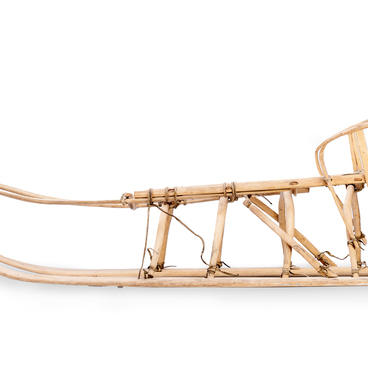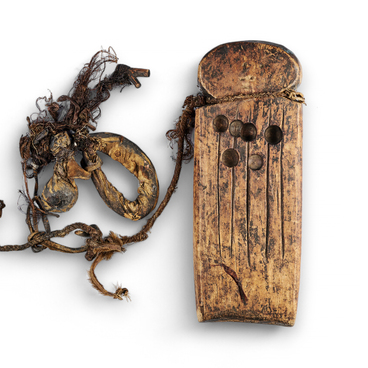This Even cradle entered the museum’s collection in 1971. It was made of three parts: a bottom with a rim, a movable canopy and an arch to which a rattle was usually attached. All wooden parts were connected with each other by means of leather straps passed through the holes.
This type of cradle was typical of all Even people settled from Transbaikalia eastward to the Sea of Okhotsk, as well as of the Nanai, Orochi, Udege, and Dolgan peoples. The joining of parts by means of leather straps made it possible to adjust the lying or semi-lying position of the baby, as well as the size of the product. For protection from cold wind and noise, the cradle was covered with deer skin. The bottom of the cradle was covered with moss.
The high sides of the cradle and the top binding prevented the child from falling out of the cradle. Three straps were used to secure the child in the cradle: one strap was for the arms, one for the tummy, and one for the legs. The arch made it possible to suspend the cradle from the saddle during migrations and to place it conveniently in the dwelling near the hearth. The main advantage of cradles was the possibility to hang them not only in the dwelling, but also in the tundra and in the forest. In Siberia, the expression “to raise children on a birch tree”, which means in a suspended cradle, is still used.
The cradle served the child for a long time, until the age of three. It was kept, passed on to the next newborn or even passed on as an inheritance. The cradle could be used by several generations of a family until it was worn out. However, if a child died, the cradle was no longer used and was taken to the forest. Babies were buried in the hollows of trees.
Researchers believe that before cradles began to be made of wood, birch bark cradles were in use. In the cultures of some ethnic groups, such as the Evenks, Evens and, in the east, the Udege and Orochi, there are remnants of the birch bark cradle. Such cradles represented boxes sewn with birch bark. Wooden cradles came into use later.
Making wooden items was men’s
work. The boards chosen for the cradle had to be thin and carefully scraped. It
became possible to produce wooden cradles once the local population already had
special tools for making thin, almost polished boards and had learned how to
bend them.



